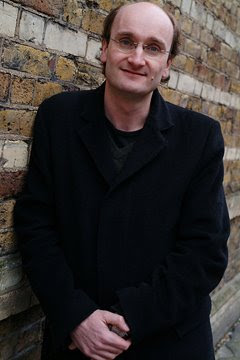The Andrew Manze Effect
 Andrew Manze, photo by Benjamin Eavolega |
The first half of the evening was devoted to an off-the-cuff lecture on what Manze calls the Eroica Effect. With the help of his orchestra's performance of works and excerpts, Manze illustrated the state of the symphonic genre at the turn of the 19th century (with different examples in each venue, judging by the reviews). He also demonstrated what made Beethoven's third symphony such a break with those traditions and how it influenced music that came after it. An affable and intelligent host, Manze had clearly studied American politics and current events to get material for his jokes. Major examples included Mozart's overture for The Magic Flute, the opening of Haydn's Die Schöpfung, and the welcome discovery of one of the symphonies of Joseph Leopold von Eybler (1765-1846). Unfortunately, the latter work was identified only with the invented moniker applied to it by Manze: a key or an HV number would have been appreciated. Was it Die vier letzten Dinge (HV 137)?
Manze's ideas were always interesting, although some that held up in this format would likely not under serious musicological scrutiny. Was the reason that Beethoven included a fugue in the third symphony really that it represented a democratization of orchestral voices? Most intriguing was the origin of the dance theme of the symphony's last movement, a simple contredanse in an early set of twelve such pieces, recorded on the group's CD. Manze implied that the contredanse required the breakdown of class distinctions, because in it one dances not only with one's partner but with everyone else as the formations shift. In the Eroica's fourth movement Beethoven explodes the dance from inside, beginning with only the bass line and gradually rebuilding it. Regrettably, neither of the other orchestral versions of the dance, recorded on the CD, appeared on the program or as an encore.
Joe Banno, Helsingborg Symphony (Washington Post, April 1) Joseph Youngblood, Helsingborg Symphony Orchestra gives lesson on Beethoven's 'Eroica' at Society of the Four Arts concert (Palm Beach Daily News, March 29) Sharon McDaniel, Examination of 'Eroica' an imperfect, heroic try (Palm Beach Post, March 29) Aaron Keebaugh, Celebrated symphony (Gainesville Sun, March 20) |
The second movement was paced like a march, not that there was no give and take, but the sense of meter was clear. The scherzo, which Manze described as a sort of diversion, comic relief from the symphony's meaty ideas, had a pleasing tempo, with some rough moments from the horn section in the trio. The same single-minded direction was evident in the fourth movement, too, where none of the pauses were indulged. The fluttering flute solo was a high point, as was the buzzing tremolo sound of the fast-paced coda. The only downside was an audience member who timed his hacking cough exactly for all of the piece's significant rests. Hint: cough during the loud parts, please.
The next major concert at George Mason will feature the 30th anniversary tour of Chanticleer (April 4, 8 pm), singing a program called My Spirit Sang All Day.





















































3 comments:
I don't know... He just looks like what he is, someone who studied classics at university and is kind of cerebral. He is never going to win any beauty contests, but I have seen worse publicity photos (including, wait for it, of Andrew Manze).
Thanks for the kind words about my site. Having heard his interesting approach to Bach, I look forward to Manze's version of the 'Eroica'.
Regards,
Eric Grunin
An Eroica Project
Post a Comment